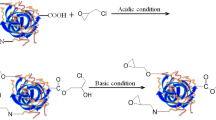Abstract
The phasing out of the use of urea–formaldehyde adhesive in the fabrication of interior-used hardwood plywood requires development of environmentally friendly bio-based wood adhesives. We recently reported that phosphorylation of soy flour (SF) using phosphoryl chloride (POCl3) greatly improved the moisture resistance of soy flour adhesive. In the present study, we investigated the effects of inorganic oxidizing agents, such as NaClO2 and Ca(NO2)2, to further improve the wet bonding strength of phosphorylated SF (PSF) wood adhesive. We report that addition of 1.8 % (wet weight basis) Ca(NO2)2 to phosphorylated SF (PSF) adhesive formulation containing 25 % soy flour solids increased the wet bonding strength to greater than 3 MPa at 140 °C hot-press temperature. The water resistance testing of the glued three-ply hardwood plywood panels passed the three-cycle soak/dry test recommended by the American National Standard for Hardwood and Decorative Plywood/Hardwood Plywood and Veneer Association protocol (ANSI/HPVA HP-1-2004). Since the process involves only inorganic chemistry and no petroleum-based chemicals such as formaldehyde or polyamidoamine–epichlorohydrin are used, the PSF + Ca(NO2)2 adhesive is non-toxic and environmentally safe.







Similar content being viewed by others
References
An Update on Formaldehyde (2013). US Consumer Product Safety Commission publication #725, US Consumer Product Safety Commission, Bethesda, MD
Airborne Toxic Control measures (ATCM) to Reduce Formaldehyde Emissions from Composite Wood Products (2007). State of California Air Resources Board Resolution No. 07-14, April 26, 2007; and Regulation Order (section 93120 to 93120-12 title 17)
Soybean Meal Monthly Price (2016) Index Mundi. http://www.indexmundi.com/commodity=soybean-meal. Accessed 23 Mar 2016
Liu Y, Li K (2002) Chemical modification of soy protein for wood adhesives. Macromol Rapid Commun 23:730–742
Wescott JM, Frihart CR, Traska AE (2006) High-soy-containing water-durable adhesives. J Adhesi Sci Technol 20:859–873
Liu Y, Li K (2004) Modification of soy protein for wood adhesives using mussel protein as a model: the influence of a mercapto group. Macromol Rapid Commun 25:1835–1838
Liu Y, Li K (2007) Development and characterization of adhesives from soy protein for bonding wood. Int J Adhesi Adhesi 27:59–67
Huang J, Li K (2008) A new soy flour-based adhesive for making interior type II plywood. J Am Oil Chem Soc 85:63–70
Jang Y, Huang J, Li K (2011) A new formaldehyde-free wood adhesive from renewable materials. Int J Adhes Adhes 31:754–759
Huang J, Li C, Li K (2012) A new soy flour-polyepoxide adhesive system for making interior plywood. Holzforschung 66:427–431
Li K, Peshkova S, Geng X (2004) Investigation of soy protein-Kymene® adhesive systems for wood composites. J Am Oil Chem Soc 81:487–491
Zhong Z, Sun XS, Wang D (2007) Isoelectric pH of polyamide–epichlorohydrin modified soy protein improved water resistance and adhesion properties. J Appl Polym Sci 103:2261–2270
Zhu D, Damodaran S (2014) Chemical phosphorylation improves the moisture resistance of soy flour-based wood adhesive. J Appl Polym Sci 131:40451
Damodaran S, Kinsella JE (1984) Dissociation of yeast nucleoprotein complexes by chemical phosphorylation. J Agric Food Chem 32:1030–1032
Frihart CR, Satori H (2013) Soy flour dispersibility and performance as wood adhesive. J Adhes Sci Technol 27:2043–2052
Ferra MM, Ohlmeyer M, Mendes AM, Costa MRN, Carvalho LH, Magalhaes FD (2011) Evaluation of urea–formaldehyde adhesives performance by recently developed mechanical tests. Int J Adhes Adhes 31:127–134
Martins J, Pereira J, Coelho C, Ferra J, Mena P, Magalhaes F, Carvalho L (2013) Adhesive bond strength development evaluation using ABES in differenct lignocllulosing materials. Int J Adhes Adhes 47:105–109
American National Standard for Hardwood and Decorative Plywood (2004) American National Standards Institute, Hardwood Plywood and Veneer Association, Reston, VA
American Standard Testing Methods (2004) ASTM D 2339-98: standard test method for strength properties on adhesives in two-ply wood construction in shear by tension loading. In: Annual book of ASTM standards, vol. 15.06. ASTM International, West Conshohocken
Kumar V, Yang T (2002) HNO2/H3PO4 – NaNO2 mediated oxidation of cellulose—preparation and characterization of bioabsorbable oxidized celluloses in high yields and with different levels of oxidation. Carbohydr Polym 48:403–412
Andre C, Niamke S, Faaure A, Colas B, Berot S, Larre C, Gueguen J, Rabiller C (2004) New methods for chemo-enzymatic galactosidation of 2S rapeseed protein. Protein J 23:247–254
Pagliaro M (1998) Autocatalytic oxidations of primary hydroxyl groups of cellulose in phosphoric acid with halogen oxides. Carbohydr Res 308:311–317
Bulla LA, Gilmour CM, Bollen WB (1970) Non-biological reduction of nitrite in soil. Nature 225:664
Acknowledgments
This research was supported by a grant (Grant No.: 11-JV-11111129-020) from the US Department of Agriculture (USDA) Forest Service, USA. We thank Dr. Charles R. Frihart at the Forest Products Laboratory, Madison, Wisconsin, for useful discussions and letting us use the ABES and other facilities at FPL.
Author information
Authors and Affiliations
Corresponding author
About this article
Cite this article
Damodaran, S., Zhu, D. A Formaldehyde-Free Water-Resistant Soy Flour-Based Adhesive for Plywood. J Am Oil Chem Soc 93, 1311–1318 (2016). https://doi.org/10.1007/s11746-016-2866-x
Received:
Revised:
Accepted:
Published:
Issue Date:
DOI: https://doi.org/10.1007/s11746-016-2866-x




